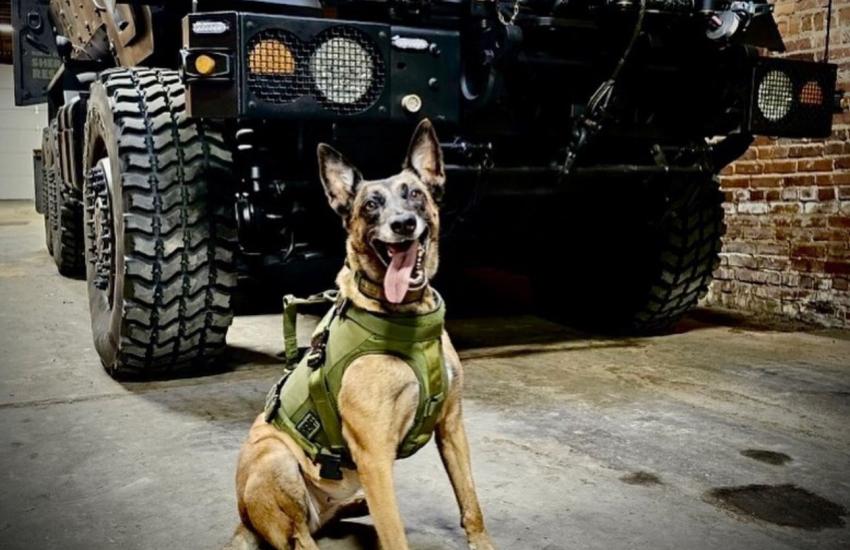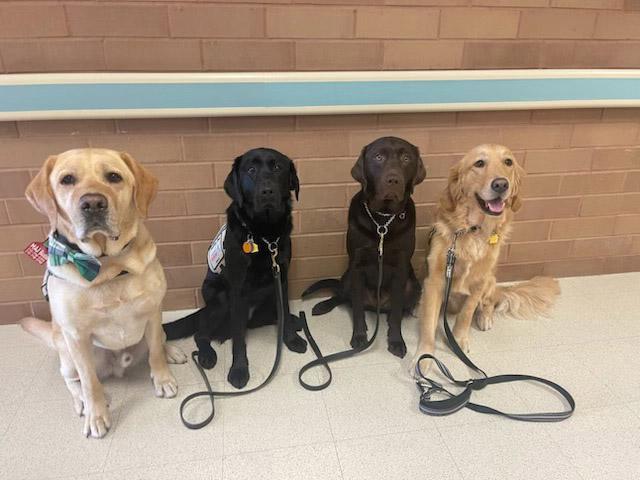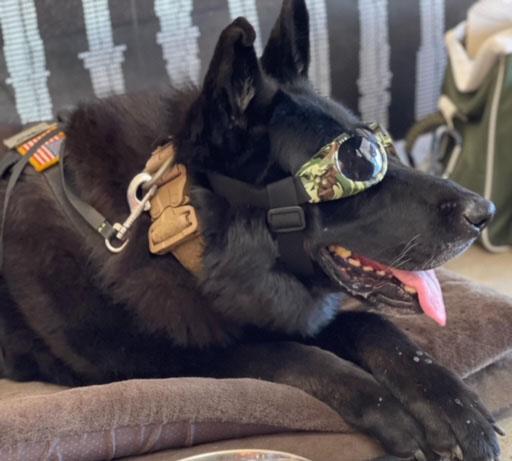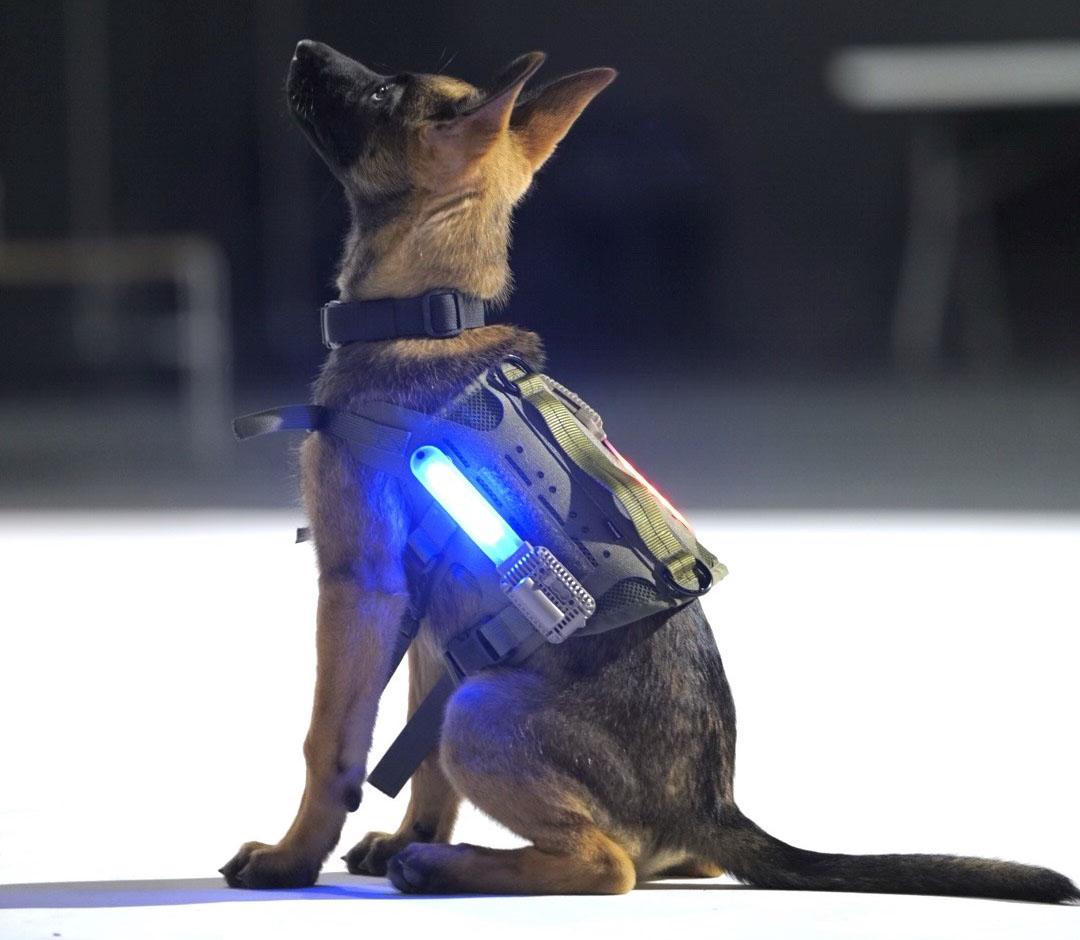For Our Four-Legged Heroes

American Humane
Though today’s most innovative minds continuously strive for a more secure environment, canine capabilities remain unparalleled.
At Brooke Army Medical Center (BAMC) in Joint Base San Antonio-Fort Sam Houston, Labrador retriever Maj. Budd is one of four facility dogs and the only one whose primary purpose is staff wellness.
“It was already hard to be in health care prior to the pandemic,” Jennifer Higgins, special assistant for health care resolutions, told SIGNAL Media. “And then the pandemic just exponentially magnified how difficult it is.”
What sounded like a crazy idea at first has proven to be successful, Higgins said. Commissioned on June 6, 2022, Maj. Budd—alongside handler Higgins—makes daily rounds at the medical center.
Eager to greet their favorite teammate, staff members line up and wait their turn as Budd approaches them one by one. “He’ll brush by all of them and will circle back to like the seventh person and lean on them,” Higgins described Budd’s signal to address the selected person and ask how they’re doing.
“I will tell you, that dog is 100% accurate every time,” she said, noting Budd’s ability to sense when someone is in emotional distress. The positive effect of having Budd on-site has been unmatched, Higgins emphasized, as she hopes the program for staff wellness facility dogs continues to grow.
Though current standards put facility dog financial responsibility on the handlers, the Defense Health Agency is currently working on rewriting a policy for facilities to cover more costs.
It’s equally important to note the mental health of facility dogs. Budd, for example, works four days a week to ensure consistent management of his energy level. “I have a clicker that I keep with me, and he had 132 people touch him last Thursday,” Higgins said. “That’s a lot of interaction for a dog.”
For Halo, a six-year-old Belgian Malinois working at the Burke County Sheriff’s Office (BCSO), a day in the life looks slightly different. As a dual-purpose canine, Halo is trained in drug detection, tracking and protection of her handler, Austin Plueger.
Plueger, who is assigned to the Special Operations Division, views Halo as a partner rather than simply a canine. “When I got her, we went to a handler school together, which is where we bond and learn all the commands,” he told SIGNAL Media. “Our agency requires us to have 16 hours a month of canine training.”
Most canines, Plueger explained, begin their training at the age of three to six months old. By the time they undergo all necessary training, including different techniques and scents, their cost can range anywhere from $12,000 to $25,000.
Echoing Higgins’ statement, Plueger affirmed canines can read people better than people can read themselves. “They know how that person is really feeling just by looking at half of their face. They know the exact emotions, whether they’re mad, angry or sad,” he said.
Unlike Budd, however, Halo must maintain a certain lifestyle and physique to remain a useful tool for her partner. The challenging aspect of being a handler, Plueger explained, was “putting all [his] trust in a nose of a dog.”

However, the courage and dedication a K-9 partner provides is worth overcoming such personal obstacles. “You have a tool that a lot of people don’t have ... they’re going to put their life down for you,” he went on.
Outside of standard veterinary checks required to ensure the well-being of a canine, many law enforcement officers within K-9 units are trained to observe and detect heat exhaustion, dehydration and any other medical concerns within their canine partners.
“Difficulties with working dogs is the heat threat,” explained CEO and K-9 Trainer at Dogs for Defense Dan Hughes. “Working overseas, in Iraq or Afghanistan, that was something we were always very cognizant of that … the dog can quickly succumb to heat stroke, and so we’re constantly looking for ways to monitor that.”
Hughes, a former U.S. Secret Service agent, and his wife Kristin Hughes, founded Dogs for Defense following the September 11, 2001, attacks. The organization pays homage to the World War II organization formed in 1942 and continues the tradition of civilians supporting national military, state and local governments with working dog solutions.
Throughout his career, Hughes has trained hundreds of dogs for drug and explosive detection, protection and more. In his experience, technology has progressed and continues to show promise.
“Probably back in the ’80s or ’90s, they came up with heat monitors for vehicles,” he said. Today, vehicle capabilities allow for handlers to receive direct alerts via mobile devices of high temperatures inside the car.
“Body temperature and heart rate are two of the biggest things [manufacturers] are monitoring,” Hughes continued. “Those are probably the biggest indicators of your dog’s health.”
One of those manufacturers is Halo Lights LLC, a company that prioritizes canine well-being by leveraging cutting-edge technology to monitor their health.
While the company’s LED collar has been commercially successful for quite some time, its newer innovation is in its final phase of development with the Department of Homeland Security Science and Technology Directorate’s Silicon Valley Innovation Program (DHS S&T SVIP).
Following the SVIP’s call for canine wearables in 2017, Chief Technology Officer and founder Jair Lahens and his team proposed an idea for harnesses that alert handlers of canines’ heat exhaustion. The innovation, named Canine Health Analytics Monitoring Platform (CHAMP), uses physiological and environmental sensors and connects to a customized mobile application.
“We just got back from Texas and Arizona,” Lahens told SIGNAL Media. After a couple of weeks of testing with the U.S. Customs and Border Protection Special Operations Group (CBP SOG), the technology company is nearing the end of its SVIP contract. “Part of the program is to commercialize the technology,” he explained. Along with being put in direct contact with the end user—in this instance the CBP—the SVIP will also recommend Halo Lights LLC to state and local agencies.
“We were actually at NSA [National Security Agency] last week, giving a presentation to Secret Service, ATF (Bureau of Alcohol, Tobacco, Firearms and Explosives], Air Force, the NSA, the NGA [National Geospatial Intelligence Agency], a lot of agencies were there ... they all agreed that there’s a need across the board for this,” Lahens said.
The technology itself is modular, he shared, which means it can attach to a harness, a collar, or whatever is most suitable for each respective agency.
Additionally, Lahens stated, his company is collaborating with PAWP, one of the largest telemedicine companies for pets. “They will connect you through FaceTime with a veterinarian,” he said. Halo Lights has developed two additional innovations specifically for the company: wearable technology, which gives vets access to a dog’s history of health and activity, and a digital stethoscope that can detect diseases.
Halo Lights LLC CEO Jason Johnson, who also runs his own nonprofit organization called Project K-9 Hero, has more than 30 years of experience in police, military, federal law enforcement and overseas contracting, with a focus on working dogs. The point of technology like CHAMP, he says, is to extend the lives of working dogs.
“The problem isn’t that [handlers] don’t get the training and don’t know what to do,” Johnson said. The true challenge is the breeds used for working dogs: German shepherds, Dutch shepherds, Belgian Malinois, Labrador retrievers and German shorthaired pointers. “That dog will work and not show signs almost until it’s too late,” he explained. “With our technology, the real key is to monitor that.”
From military working dogs (MWDs) to drug and explosive detection K-9s, the duties of four-legged heroes have varied throughout history. Nevertheless, their sole purpose remains the same: to provide immeasurable safety and support as the most loyal of companions.
“Cry ‘Havoc!’ and let slip the dogs of war,” William Shakespeare wrote in his 1599 play, Julius Caesar. On record, Egyptians, Greeks and Romans first began using canines in combat around 600 BC. However, in World War II, their service as war heroes was officially recognized, and the Army stood up its canine corps.
“It wasn’t until the Vietnam War that the military saw the need to maintain the MWD program,” Sgt Maj. Viridiana Lavalle, U.S. Army MWD program manager, told SIGNAL Media. More than 4,000 war dogs supported the conflict and were accredited to saving over 10,000 lives. “Vietnam handlers paved the way for the rest of us,” Lavalle stated.
Since then, each service has eventually adopted and developed its own MWD program. According to the Department of Defense (DoD), there are currently around 1,600 U.S. military working dogs stationed worldwide.
Just 15 years ago, then commanding general of multi-national forces in Iraq, Gen. David H. Petraeus, stated, “The capability that military working dogs bring to the fight cannot be replicated by man or machine. By all measures of performance, their yield outperforms any asset we have in our inventory. Our Army would be remiss if we failed to invest more in this incredibly valuable resource.”
Today, the Army is using additional emerging technologies such as hearing protection tools, camera systems to control canines from a safe distance and harnesses to allow canines to be parachuted. Most recently, Lavalle shared, the DoD MWD services has initiated a canine holistic health fitness program, which is currently in its concept phase. “We’re looking at incorporating various enrichment tools into the kennel environment to increase quality of life for the MWD,” she said. “We’re also working on MWD socialization initiatives, where we’re starting to allow military working dogs to socialize amongst each other versus before, historically, we would keep MWD separated from one another.”
Physical conditioning programs are also implemented at the kennel level to increase the overall quality of life and well-being for Army working dogs.
“Our military working dogs are also tactical military athletes, so we owe it to our military working dogs to ensure that they are fit for duty, not just physically, but also mentally,” Lavalle concluded.






Comments